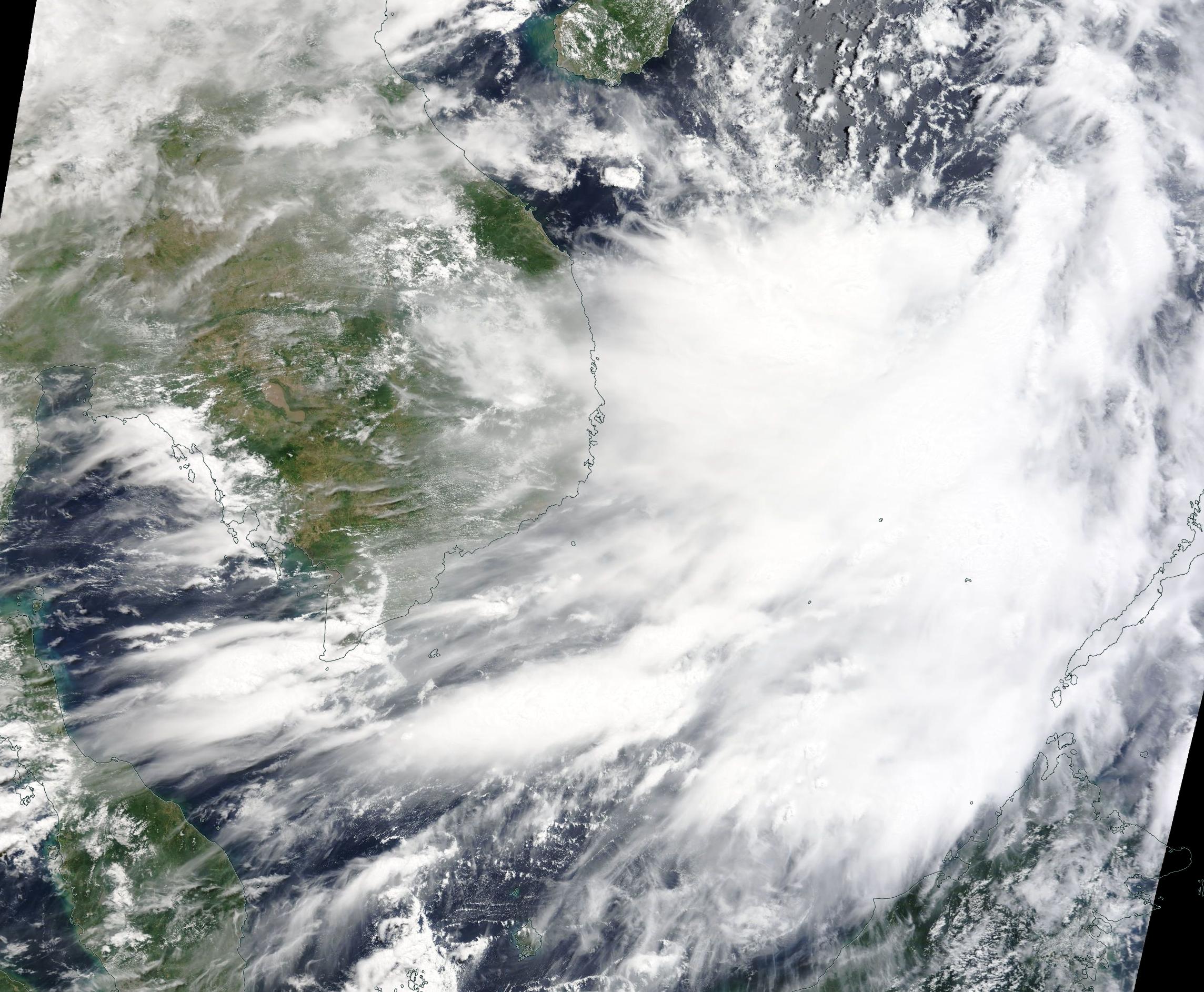Images
July 1, 2022 - Tropical Storm Chaba takes aim at China
Tweet
Tropical Storm Chaba formed from a tropical depression over the South China Sea on June 29, 2022. Initially named Caloy by the Philippine Atmospheric, Geophysical and Astronomical Services Administration (PAGASA), the system was also dubbed 04W by the Joint Typhoon Warning Center (JTWC) and, as the storm strengthened and moved westward, the Japan Meteorological Agency gave it the designation Tropical Storm Chaba.
On June 30, the Moderate Resolution Imaging Spectroradiometer (MODIS) on board NASA’s Terra satellite acquired a true-color image of Tropical Storm Chaba as it was strengthening and moving towards mainland China. At that time, the cloud-filled eye was indistinct, and the western side of the system was bringing rain to Vietnam while the eastern edge of Chaba was interacting with parts of the Philippines.
Later that evening, at 2100 UTC (5:00 p.m. EDT), the JTWC advised that Tropical Storm Chaba was carrying maximum sustained winds of 46 mph (64 km/h) and gusts up to 63.3 mph (102 km/h). The center of the storm was located about 326 miles (525 km) south of Hong Kong and was tracking northwestward.
Tropical Storm Chaba is heading towards environmental conditions favorable for strengthening and is predicted to make landfall east of the Luichow Peninsula as early as late on July 1. The JTWC expects the storm to achieve maximum sustained winds of 75 mph (121 km/h) before coming ashore. This would be the equivalent of a Category One storm on the Saffir-Simpson Hurricane Wind Scale. The JTWC also notes there is also a risk of rapid intensification during the next 24 hours. However, as Chaba interacts both with the island of Hainan and then mainland China, it will begin to degrade. It is expected to dissipate a day or two after landfall as it moves northward over China.
Image Facts
Satellite:
Terra
Date Acquired: 6/30/2022
Resolutions:
1km (2.1 MB), 500m (5.8 MB), 250m (3.9 MB)
Bands Used: 1,4,3
Image Credit:
MODIS Land Rapid Response Team, NASA GSFC
Tweet
Tropical Storm Chaba formed from a tropical depression over the South China Sea on June 29, 2022. Initially named Caloy by the Philippine Atmospheric, Geophysical and Astronomical Services Administration (PAGASA), the system was also dubbed 04W by the Joint Typhoon Warning Center (JTWC) and, as the storm strengthened and moved westward, the Japan Meteorological Agency gave it the designation Tropical Storm Chaba.
On June 30, the Moderate Resolution Imaging Spectroradiometer (MODIS) on board NASA’s Terra satellite acquired a true-color image of Tropical Storm Chaba as it was strengthening and moving towards mainland China. At that time, the cloud-filled eye was indistinct, and the western side of the system was bringing rain to Vietnam while the eastern edge of Chaba was interacting with parts of the Philippines.
Later that evening, at 2100 UTC (5:00 p.m. EDT), the JTWC advised that Tropical Storm Chaba was carrying maximum sustained winds of 46 mph (64 km/h) and gusts up to 63.3 mph (102 km/h). The center of the storm was located about 326 miles (525 km) south of Hong Kong and was tracking northwestward.
Tropical Storm Chaba is heading towards environmental conditions favorable for strengthening and is predicted to make landfall east of the Luichow Peninsula as early as late on July 1. The JTWC expects the storm to achieve maximum sustained winds of 75 mph (121 km/h) before coming ashore. This would be the equivalent of a Category One storm on the Saffir-Simpson Hurricane Wind Scale. The JTWC also notes there is also a risk of rapid intensification during the next 24 hours. However, as Chaba interacts both with the island of Hainan and then mainland China, it will begin to degrade. It is expected to dissipate a day or two after landfall as it moves northward over China.
Image Facts
Satellite:
Terra
Date Acquired: 6/30/2022
Resolutions:
1km (2.1 MB), 500m (5.8 MB), 250m (3.9 MB)
Bands Used: 1,4,3
Image Credit:
MODIS Land Rapid Response Team, NASA GSFC




